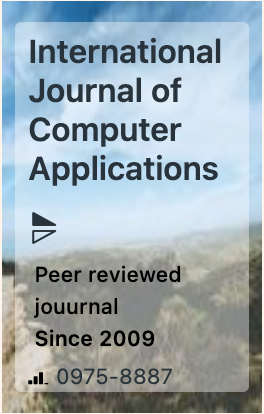The week's pick
Random Articles
Reseach Article
AI-Driven Border Security System using Thermal Images
| International Journal of Computer Applications |
| Foundation of Computer Science (FCS), NY, USA |
| Volume 187 - Number 13 |
| Year of Publication: 2025 |
| Authors: Shashikant Mharasale, Sarita Sapkal |
 10.5120/ijca2025925162
10.5120/ijca2025925162
|
Shashikant Mharasale, Sarita Sapkal . AI-Driven Border Security System using Thermal Images. International Journal of Computer Applications. 187, 13 ( Jun 2025), 16-20. DOI=10.5120/ijca2025925162
Abstract
In the realm of border security, integrating artificial intelligence (AI) with thermal imaging technology has emerged as a powerful approach for enhancing surveillance and threat detection. These AI-driven solutions offer significant potential for optimizing border monitoring systems, which is increasingly essential in today’s interconnected security landscape. Nature-inspired algorithms, combined with machine learning, have shown promise in addressing various challenges, such as maximizing system lifespan, efficient data aggregation, robust connectivity, and achieving optimal coverage across expansive border areas. Coverage optimization is especially critical in border security, and numerous algorithms have been developed to tackle this issue. However, as the number of thermal imaging devices deployed within a surveillance range grows, these algorithms may struggle to avoid getting trapped in local optima, thus hindering comprehensive coverage. To address this, exploring advanced global metaheuristics and bio-inspired algorithms that can be adapted or combined to escape local optima and achieve effective global optimization in border security applications is essential. This paper reviews the current state of AI and nature-inspired algorithms for enhancing border security through thermal imaging technology. It examines unresolved research questions and proposes potential directions for future research. Through bibliometric analysis, we identify prevalent models, such as binary and probabilistic sensing models, and primary coverage scenarios, like target and k-barrier coverage, which are extensively studied in border security contexts. Additionally, genetic algorithms and particle swarm optimization emerge as the most commonly used algorithms for analyzing coverage issues. This review aims to support researchers in advancing border security by leveraging AI and nature-inspired algorithms. It provides a comprehensive overview of the existing literature, highlights research gaps, and offers guidance for future studies on enhancing border security using AI-augmented thermal imaging technology.
References
- R. P. Singh, M. K. Saini, and V. Sharma, “Thermal imaging and its role in smart surveillance for border security,” Sensors, vol. 20, no. 22, pp. 6543–6558, 2021.
- A. S. Al‑Kaff et al., “UAV‑based thermal sensing for border monitoring: A comprehensive review,” IEEE Access, vol. 9, pp. 74592–74610, 2022.
- T. T. Kim and S. H. Lee, “AI‑based threat detection for global security cooperation,” Defence Stud., vol. 21, no. 2, pp. 148–163, 2021.
- D. Gavrilov and A. Touma, “LiDAR‑based object detection in low‑visibility environments,” IEEE Trans. Geosci. Remote Sens., vol. 57, no. 4, pp. 2351–2362, Apr. 2019.
- N. Vavoula, "Artificial Intelligence (AI) at Schengen Borders: Automated Processing Algorithmic Profiling and Facial Recognition in the Era of Techno-Solutionism" in European Journal of Migration and Law, Brill, vol. 23, no. 4, pp. 457-484, Dec. 21, 2021.
- R. Ezhilarasie, N. Aishwarya, V. Subramani and A. Umamakeswari, "Acceleration of computer vision and deep learning: Surveillance systems" in Handbook of Research on Computer Vision and Image Processing in the Deep Learning Era, IGI Global, pp. 19-28, 2023
- P. K. Verma, S. Singh, and M. Jaiswal, “Smart surveillance using AI and IoT: Border security perspectives,” Procedia Comput. Sci., vol. 167, pp. 1574–1583, 2020.
- T. T. Kim and S. H. Lee, “AI‑based threat detection for global security cooperation,” Defence Stud., vol. 21, no. 2, pp. 148–163, 2021.
- Kabir, M. S. and Alam, M. N. "The Role of AI Technology for Legal Research and Decision Making," Title of the Journal, 2023.
Index Terms
Keywords

